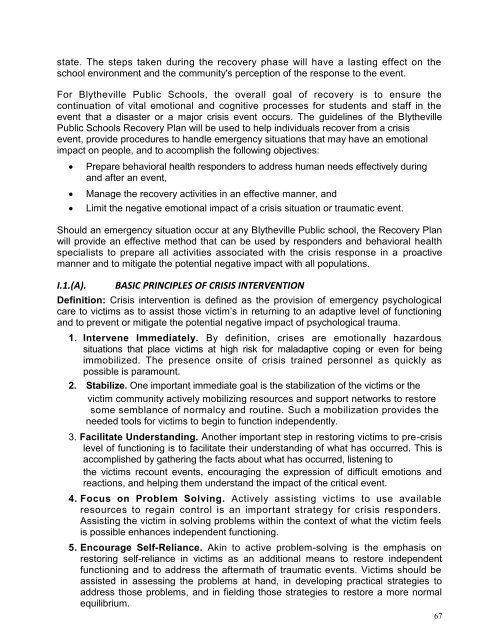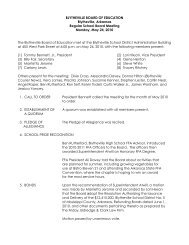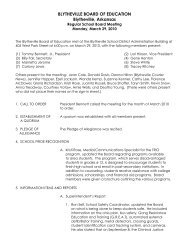District-Wide Safe Schools and Crisis Plan - Blytheville Public Schools
District-Wide Safe Schools and Crisis Plan - Blytheville Public Schools
District-Wide Safe Schools and Crisis Plan - Blytheville Public Schools
Create successful ePaper yourself
Turn your PDF publications into a flip-book with our unique Google optimized e-Paper software.
state. The steps taken during the recovery phase will have a lasting effect on the<br />
school environment <strong>and</strong> the community's perception of the response to the event.<br />
For <strong>Blytheville</strong> <strong>Public</strong> <strong>Schools</strong>, the overall goal of recovery is to ensure the<br />
continuation of vital emotional <strong>and</strong> cognitive processes for students <strong>and</strong> staff in the<br />
event that a disaster or a major crisis event occurs. The guidelines of the <strong>Blytheville</strong><br />
<strong>Public</strong> <strong>Schools</strong> Recovery <strong>Plan</strong> will be used to help individuals recover from a crisis<br />
event, provide procedures to h<strong>and</strong>le emergency situations that may have an emotional<br />
impact on people, <strong>and</strong> to accomplish the following objectives:<br />
Prepare behavioral health responders to address human needs effectively during<br />
<strong>and</strong> after an event,<br />
Manage the recovery activities in an effective manner, <strong>and</strong><br />
Limit the negative emotional impact of a crisis situation or traumatic event.<br />
Should an emergency situation occur at any <strong>Blytheville</strong> <strong>Public</strong> school, the Recovery <strong>Plan</strong><br />
will provide an effective method that can be used by responders <strong>and</strong> behavioral health<br />
specialists to prepare all activities associated with the crisis response in a proactive<br />
manner <strong>and</strong> to mitigate the potential negative impact with all populations.<br />
I.1.(A). BASIC PRINCIPLES OF CRISIS INTERVENTION<br />
Definition: <strong>Crisis</strong> intervention is defined as the provision of emergency psychological<br />
care to victims as to assist those victim’s in returning to an adaptive level of functioning<br />
<strong>and</strong> to prevent or mitigate the potential negative impact of psychological trauma.<br />
1. Intervene Immediately. By definition, crises are emotionally hazardous<br />
situations that place victims at high risk for maladaptive coping or even for being<br />
immobilized. The presence onsite of crisis trained personnel as quickly as<br />
possible is paramount.<br />
2. Stabilize. One important immediate goal is the stabilization of the victims or the<br />
victim community actively mobilizing resources <strong>and</strong> support networks to restore<br />
some semblance of normalcy <strong>and</strong> routine. Such a mobilization provides the<br />
needed tools for victims to begin to function independently.<br />
3. Facilitate Underst<strong>and</strong>ing. Another important step in restoring victims to pre-crisis<br />
level of functioning is to facilitate their underst<strong>and</strong>ing of what has occurred. This is<br />
accomplished by gathering the facts about what has occurred, listening to<br />
the victims recount events, encouraging the expression of difficult emotions <strong>and</strong><br />
reactions, <strong>and</strong> helping them underst<strong>and</strong> the impact of the critical event.<br />
4. Focus on Problem Solving. Actively assisting victims to use available<br />
resources to regain control is an important strategy for crisis responders.<br />
Assisting the victim in solving problems within the context of what the victim feels<br />
is possible enhances independent functioning.<br />
5. Encourage Self-Reliance. Akin to active problem-solving is the emphasis on<br />
restoring self-reliance in victims as an additional means to restore independent<br />
functioning <strong>and</strong> to address the aftermath of traumatic events. Victims should be<br />
assisted in assessing the problems at h<strong>and</strong>, in developing practical strategies to<br />
address those problems, <strong>and</strong> in fielding those strategies to restore a more normal<br />
equilibrium.<br />
67
















